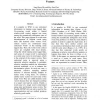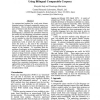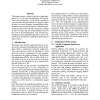104 search results - page 1 / 21 » Word Sense Disambiguation by Relative Selection |
IJCNLP
2005
Springer
14 years 26 days ago
2005
Springer
Abstract. This paper describes a novel method for a word sense disambiguation that utilizes relatives (i.e. synonyms, hypernyms, meronyms, etc in WordNet) of a target word and raw ...
COLING
2002
13 years 7 months ago
2002
It is popular in WSD to use contextual information in training sense tagged data. Co-occurring words within a limited window-sized context support one sense among the semantically...
COLING
2002
13 years 7 months ago
2002
An unsupervised method for word sense disambiguation using a bilingual comparable corpus was developed. First, it extracts statistically significant pairs of related words from th...
COLING
2000
13 years 8 months ago
2000
This paper presents a robust client/server implementation of a word sense disambiguator for English. This system associates a word with its meaning in a given context using dictio...
BMCBI
2010
13 years 7 months ago
2010
Background: Word sense disambiguation (WSD) algorithms attempt to select the proper sense of ambiguous terms in text. Resources like the UMLS provide a reference thesaurus to be u...



